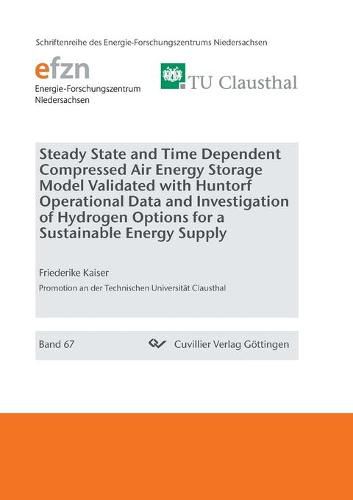Readings Newsletter
Become a Readings Member to make your shopping experience even easier.
Sign in or sign up for free!
You’re not far away from qualifying for FREE standard shipping within Australia
You’ve qualified for FREE standard shipping within Australia
The cart is loading…






This title is printed to order. This book may have been self-published. If so, we cannot guarantee the quality of the content. In the main most books will have gone through the editing process however some may not. We therefore suggest that you be aware of this before ordering this book. If in doubt check either the author or publisher’s details as we are unable to accept any returns unless they are faulty. Please contact us if you have any questions.
Wind power and photovoltaic energy play a significant role in sustainable energy systems. However, these two renewable energy sources do not generate electrical energy on demand and are subject to natural fluctuations. Thus, the need for compensatory measures arises. Compressed air energy storage power plants (CAES) are a possible solution to providing negative and positive control energy in the electric grid. However, in contrast to other energy storage devices such as pumped hydro energy storage or batteries, the storage medium compressed air hardly contains any energy (or more precisely: enthalpy). Yet, compressed air storage allows the operation of highly efficient gas turbines, which are not only particularly fast available but also achieve better efficiency than combined cycle power plants used today, as illustrated by the example of the modern gas and steam power plant Irsching with tc = 60%from 2011 compared to the 20 years older McIntosh CAES with tc = 82.4 %. In this thesis, the calculation methods for the thermodynamics of the CAES process are presented and validated by measured data from the operations of the CAES power plant Huntorf. Both the steady state and the dynamic (time-dependent) analyses of the process take place. The characteristic value efficiency is discussed in detail, since numerous different interpretations for CAES exist in the literature. A new calculation method for the electric energy storage efficiency is presented, and a method for the calculation of an economically equivalent electricity storage efficiency is developed. Consideration is given to the transformation of the CAES process into a hydrogen-driven and, thus, greenhouse gas-free process. Finally, a model CAES system is tested in a 100 % renewable model environment. Consequently, it can be stated that in the steady-state thermodynamic calculation in particular, the consideration of realistic isentropic efficiencies of compressors and turbines is essential to correctly esti
$9.00 standard shipping within Australia
FREE standard shipping within Australia for orders over $100.00
Express & International shipping calculated at checkout
This title is printed to order. This book may have been self-published. If so, we cannot guarantee the quality of the content. In the main most books will have gone through the editing process however some may not. We therefore suggest that you be aware of this before ordering this book. If in doubt check either the author or publisher’s details as we are unable to accept any returns unless they are faulty. Please contact us if you have any questions.
Wind power and photovoltaic energy play a significant role in sustainable energy systems. However, these two renewable energy sources do not generate electrical energy on demand and are subject to natural fluctuations. Thus, the need for compensatory measures arises. Compressed air energy storage power plants (CAES) are a possible solution to providing negative and positive control energy in the electric grid. However, in contrast to other energy storage devices such as pumped hydro energy storage or batteries, the storage medium compressed air hardly contains any energy (or more precisely: enthalpy). Yet, compressed air storage allows the operation of highly efficient gas turbines, which are not only particularly fast available but also achieve better efficiency than combined cycle power plants used today, as illustrated by the example of the modern gas and steam power plant Irsching with tc = 60%from 2011 compared to the 20 years older McIntosh CAES with tc = 82.4 %. In this thesis, the calculation methods for the thermodynamics of the CAES process are presented and validated by measured data from the operations of the CAES power plant Huntorf. Both the steady state and the dynamic (time-dependent) analyses of the process take place. The characteristic value efficiency is discussed in detail, since numerous different interpretations for CAES exist in the literature. A new calculation method for the electric energy storage efficiency is presented, and a method for the calculation of an economically equivalent electricity storage efficiency is developed. Consideration is given to the transformation of the CAES process into a hydrogen-driven and, thus, greenhouse gas-free process. Finally, a model CAES system is tested in a 100 % renewable model environment. Consequently, it can be stated that in the steady-state thermodynamic calculation in particular, the consideration of realistic isentropic efficiencies of compressors and turbines is essential to correctly esti